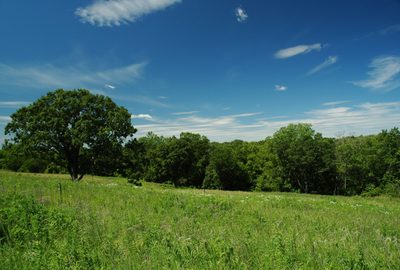
Though common at one time in southern Minnesota, the oak savanna community is essentially extinct in the state. The community was dependent on fires to maintain a park-like open forest, with scattered trees that did not have a closed canopy. Once fires were suppressed after European settlement, the savannas were very quickly grown over by fire-intolerant trees and shrubs. These in turn shaded out the full-sun plant species often found in savannas.
Records from the General Land Survey of Rice and Dakota Counties show that the southeastern banks of the Cannon River in the Arb historically were oak savanna. This can be seen today by the presence of many old (over a century) bur oaks (Quercus macrocarpa) in the Arb forests, now overgrown by fire-intolerant species. European buckthorn (Rhamnus cathartica) is a particularly aggressive invader in these degraded oak habitats.
Because the original oaks still remain, the Arb offers a unique opportunity to reconstruct this extremely rare ecological community. Starting in the 1980s, students began to remove the invading fire-intolerant trees and shrubs such as European buckthorn and bush honeysuckle in the Oak Opening project in the Lower Arb.
Oak savanna restoration proceeds in several steps. The first is to remove woody vegetation from around the oak trees, a time- and labor-intensive activity. These plants would quickly re-invade unless steps are taken to keep them out. The Arb savannas will be kept open by trying to approximate the original fire regime. After woody plant removal, grasses and wildflowers are planted into the savannas; these are essential in allowing the fire to carry well through the savanna and prevent re-invasion by trees and shrubs.
Fire is essential to managing both prairie and oak savanna, so the main oak savanna restoration will be immediately adjacent to the large prairie restoration in the Lower Arb. This will allow a fire management program that approximates natural conditions: prairie fires sweeping into the woods at the prairie-forest border. The proximity of oak savanna to prairie is also important because these two communities share many species, and it can be expected that some species introduced into the prairies will migrate into the oak savanna and vice versa.
Smaller oak savannas will be restored near prairies in the Upper Arb. The Wright Savanna was cleared and planted in 1992, adjacent to Postage Stamp Prairie. There are other potential savanna restoration sites scattered through the Upper Arb.